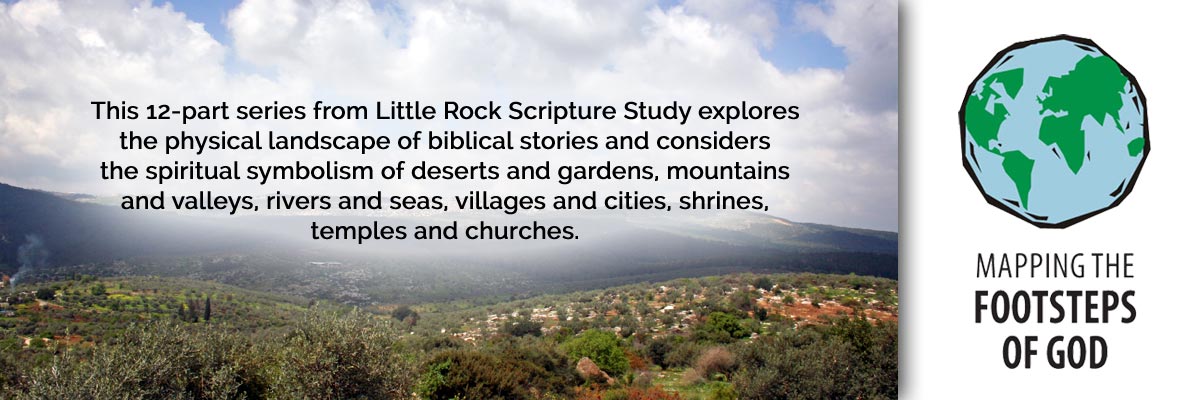Official Website of the
Catholic Diocese of Little Rock
Both war, peace found in biblical valleys
Published: May 24, 2014
This is the fifth column in a 12-part series
By Cackie Upchurch
Director of Little Rock Scripture Study
When I drive through the Ozark Mountains of my home state there are a number of valleys that always catch my breath as I round a bend or descend into the shady lower roadways. These spots feel tranquil, like a cool and inviting respite from the steering-wheel clutching curves of the mountain highways.
 Psalm 23 describes God as the shepherd who leads his flock into verdant pastures near still waters. Given our own glimpse of these restful places in the natural world it is little wonder that so many artists and musicians have popularized what is undoubtedly one of the best known psalms of the Bible.
Psalm 23 describes God as the shepherd who leads his flock into verdant pastures near still waters. Given our own glimpse of these restful places in the natural world it is little wonder that so many artists and musicians have popularized what is undoubtedly one of the best known psalms of the Bible.
Psalm 23 goes on, however, to speak of God's protecting and comforting presence through the "valley of the shadow of death," alerting us to the fact that not all tranquil scenes are what they appear to be on the surface. In fact, there are a number of valley scenes depicted in Scripture that hold layers of meaning.
One location that stands both as a remembrance of shame and a sign of hope is the Valley of Achor, a stretch of land approaching Jericho from the southwest. It was the site where one of the members of the tribe of Judah, along with his family, was stoned to death for violating the statutes of holy war and plundering the city after the conquest of Jericho (Joshua 6-8). This same valley was later used in Hosea 2:17 and Isaiah 65:10 as a sign of hope for the kingdoms of Israel and Judah. God's final word for this valley associated with the original conquest of Canaan is not disaster or punishment but restoration of God's people.
There are a couple of valleys especially noted in the Bible for their associations with decisive battles. One is the Valley of Elah, an important route from the coastal cities inland to places such as Bethlehem and Jerusalem. I Samuel 17 identifies this flat triangular area as the place where young David defeated the imposing Philistine war hero Goliath by using a simple slingshot. David's fame brought him to the attention of King Saul, and would later become a legendary piece of his own history as the second of Israel's kings.
The Jezreel Valley, also known as the Plain of Megiddo, is a vast area that stretches north and east from Mount Carmel (the site of Elijah's defeat of the priests of Baal and his encounter with the still small voice of God) all the way to Mount Tabor (the site now associated with the Transfiguration of Jesus). The vision John recorded in the book of Revelation indicates a final decisive battle between good and evil known as Armegeddon, named for Mount Megiddo from where so many of Israel's battles could be seen — the victory of Deborah and the Israelite troops over the Canaanites (Judges 5:19), as well as the battle deaths of King Ahaziah (2 Kings 9:27) and King Josiah (2 Kings 23:29) to name a few.
Another kind of battle is associated with two valleys mentioned in the Gospels. Gehenna is a small valley to the southwest of the ancient walls of Jerusalem. Originally a welcome barrier for the capital city, for a time it was a site of human sacrifice later cursed by the prophet Jeremiah in 7:32 and 19:6, and alluded to in Isaiah 66 as a place for the dead bodies of those who rebelled against God. In New Testament times, the location was a garbage dump, where fires burned almost continually to rid the area of waste and disease. There is little wonder that the "fires of Gehenna" came to be associated in some writings with eternal punishment (e.g., Matthew 5:22; 18:9; Luke 12:5).
Finally, consider the Kidron Valley, located outside of the eastern wall of Jerusalem between the city and the Mount of Olives. This is the valley that was at one time filled with royal gardens (2 Kings 25:4; Nehemiah 3:15), then became the resting place of Judah's kings and generations of Israel's people. Jesus himself crossed the Kidron Valley after his final supper with his followers as he made his way to the Garden of Gethsemene and the arrest that would lead to his crucifixion.
Doing battle, whether an internal struggle or one that is more cosmic in nature, is often associated in Scripture with valleys. No wonder the psalmist wants the assuring presence of the Good Shepherd as he walks through the valley of the shadow of death.
Study Questions
- What do you associate with valleys when you consider nature? How are nature's valleys also associated with rhythms in our spiritual lives?
- Read the passage in Hosea 2:16-17 where the prophet describes God's desire to renew the covenant with Israel? Why is the Valley of Achor an important reference?
- Read about the Kidron Valley in the final days of the life of Jesus (see John 18:1-14), and locate it on a biblical map of Jerusalem. How does some knowledge of the valley's history help you imagine the scene in the life of Jesus?
- Some spiritual writers believe that valley experiences more so than mountaintop experiences mature us in our life of faith. What has been your experience in this regard?
This article was originally published in Arkansas Catholic May 24, 2014. Copyright Diocese of Little Rock. All rights reserved. This article may be copied or redistributed with acknowledgement and permission of the publisher.




